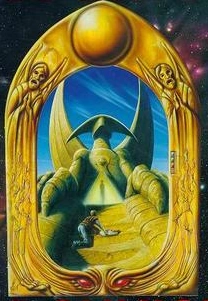
The Sphinx as depicted in "The Time Tombs of Hyperion" by EofAlien on Deviantart.
"The Sphinx" is the informal label given to one of the structures found in the Valley of the Time Tombs on Hyperion.
Overview[]
The Sphinx is a massive structure built out of stone blocks, much like the Ancient Egyptian monument on Old Earth after which it is named. Like its namesake, it appears to be modeled on a sphinx, a mythological creature with the head of a human, the wings of an eagle and the body of a lion; however, while the lines and curvature of the monument are suggestive of a face, leonine torso and wings, it remains unclear whether it is actually a representation of such an creature or if it is an abstract sculpture.
The Sphinx is riddled with numerous narrow corridors, none of which appear to lead to anywhere in particular. The corridors fluctuate wildly in width, sometimes expanding into massive chambers and at other times shrinking to extremely small proportions. Arches and doorways in the structure also vary in dimensions, with some being rectangular and others being hexagonal, triangular, decagonal or other unconventional shapes.
As with all of the Time Tombs, the Sphinx is inundated with an anti-entropic field that causes temporal distortions, known as "time tides," that vary in intensity over time. Out of all the Tombs, however, the Sphinx seems to be the least affected by this phenomenon.
Purpose[]

The Sphinx as portrayed on an alternative cover of The Fall of Hyperion.
The Sphinx is a one-way time portal to the period in time when the Time Tombs were first completed and sent on their journey backward in time. Not all who attempt to travel through the Sphinx are successful. The mechanism by which the Sphinx determines who is admitted entry is unknown. In the six months following the opening of the Time Tombs, only three people have been admitted entry: Sol Weintraub, his infant daughter Rachel, and the Ouster Mizenspesht Ammenyet, out of hundreds who have made the attempt.[1]
References[]
- ↑ The Fall of Hyperion. Epilogue. 1995 edition, pg. 511.